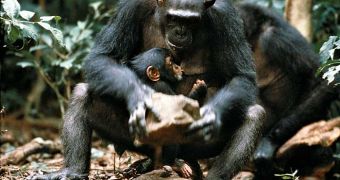This looks like another Congolese myth: huge jungle apes that kill lions, catch fish and even howl at the moon. The legends speak about a legendary creature, a type of hybrid between a chimp and a gorilla.
But how to investigate this in the middle of one of the bloodiest conflicts on the planet, the civil war in the Democratic Republic of Congo? Getting to the area means negotiating the shifting fortunes of warring rebel factions, not to mention the impenetrable forest. Still, a few researchers have managed to study the animals. The creatures which were found were not yeti or a chimp/gorilla hybrid, but the reality proved even more fascinating.
It seemed to be all about a unique race of giant chimps with a unique culture and with a peculiar taste for big cat meat. Cleve Hicks, at the University of Amsterdam has spent 18 months in the field investigating the Bili apes (christened after a nearby town) since 2004.
His most striking discovery came after one of his trackers heard chimps calling for several days from the same location; when he went there, he found a chimp feasting on the carcass of a leopard. Hicks cannot testify the chimps killed by the leopard, but this gives credits to their lion-eating reputation.
"What we have found is this completely new chimpanzee culture," said Hicks, who has got the first shots of these chimps. Arriving to the chimps' habitat requires a bitter 40km (25-mi) trek through the jungle, from the nearest road, having to cross crocodile infested streams. But this protected the chimps from human encroachment and the apes had no normal fear of humans. Chimps living near the road flee as soon as they see people because they are the victims of bushmeat trade and know the consequences of a rifle.
Unlike other chimps, the Bili chimps regularly bed down for the night in ground nests, in about 20 % of the cases.
"How can they get away with sleeping on the ground when there are lions, leopards, golden cats around as well as other dangerous animals like elephants and buffalo? I don't like to paint them as being more aggressive, but maybe they prey on some of these predators and the predators kind of leave them alone." said Hicks.
"The ground nests were very big and there was obviously something very unusual going on there. They are not unknown elsewhere but very unusual," said Colin Groves, an expert on primate morphology at the Australian National University in Canberra who saw the nests in the field.
Groves thinks the Bili chimps represent a fourth race of chimps that should be added to the already recognized three ones. "The animals also have a "smashing culture" - a blunt but effective way of solving problems," said Hicks.
His team discovered hundreds of snails and hard-shelled fruits smashed for food and observed chimps carrying termite mounds to rocks to smash them and these chimps were also found eating turtles, by, of course, smashing their shells. Like Tanzanian chimps observed by Jane Goodall, the Bili chimps use sticks to fish ants, but their tools are up to 2.5 m (8.3 ft) long.
An exciting discovery is that this population could be one of the largest remaining continuous chimp populations. In an area of 7,000 square km (2,750 square mi), Hicks' team discovered chimps everywhere. But their future could be bleak. "Things are not promising. The absence of a strong central government has resulted in most of the region becoming more independent and lawless. In conservation terms this is a disaster." said Karl Ammann, an independent wildlife photographer.

 14 DAY TRIAL //
14 DAY TRIAL //